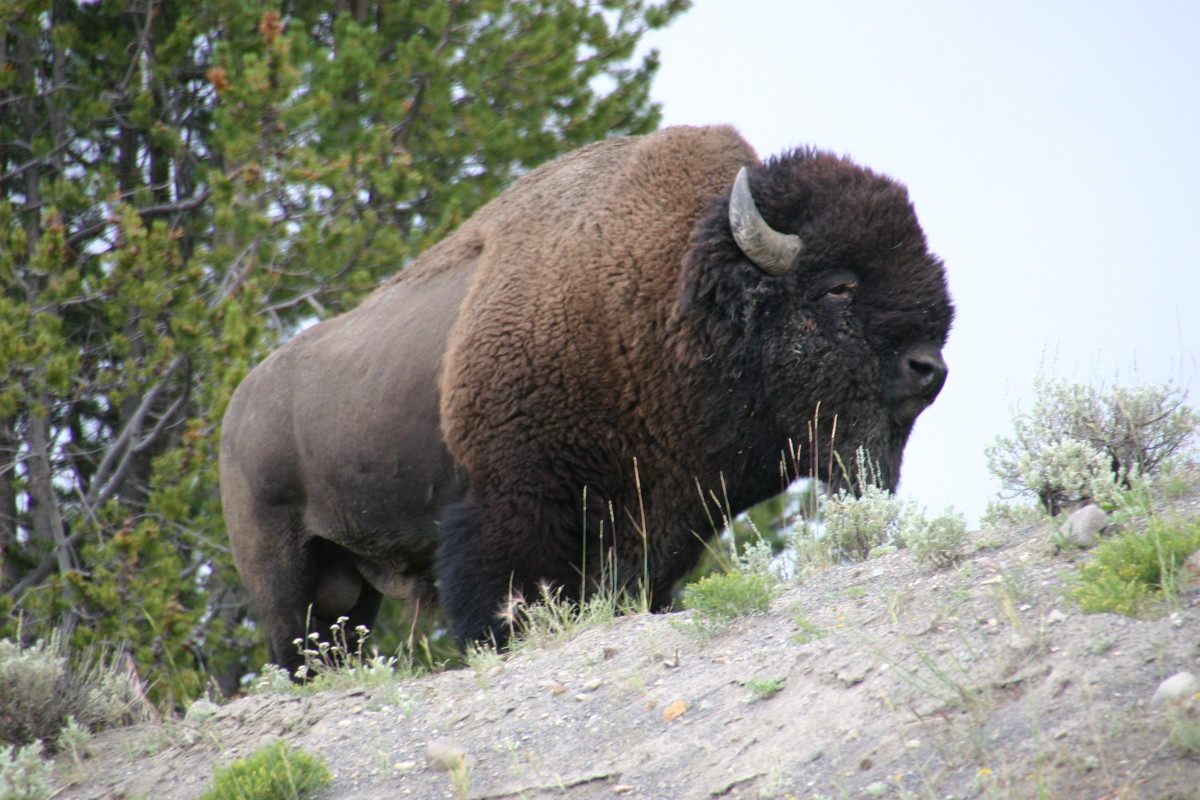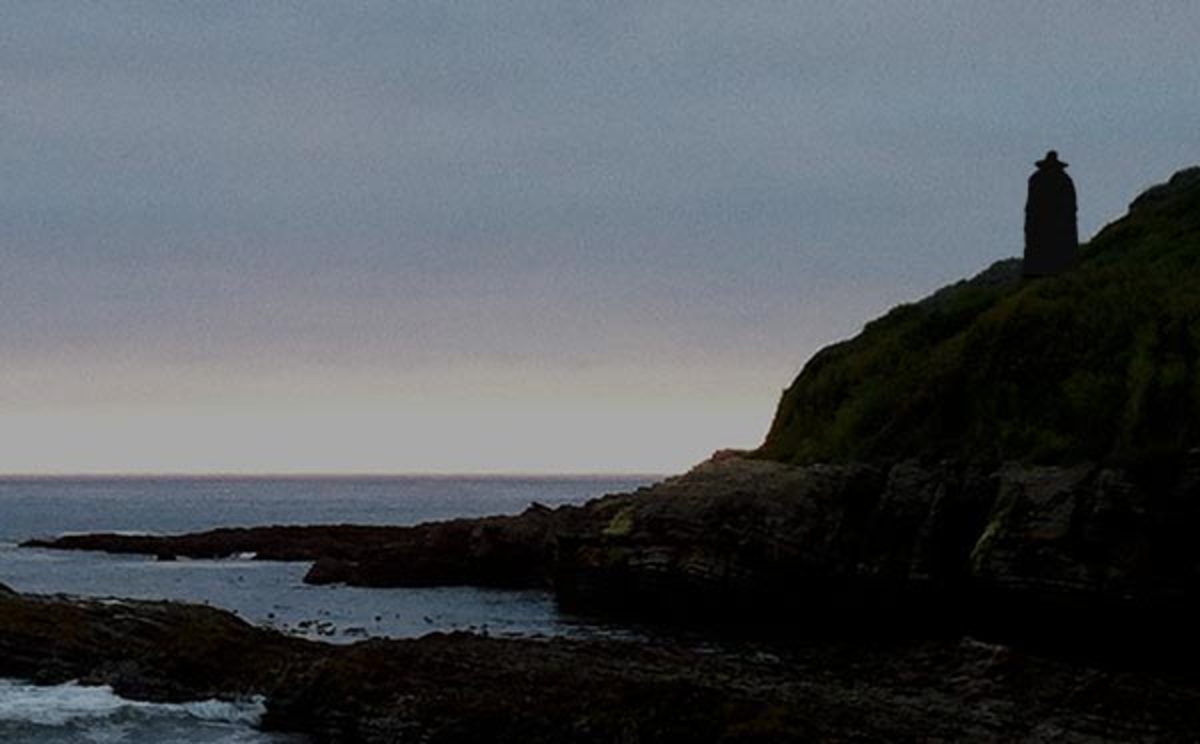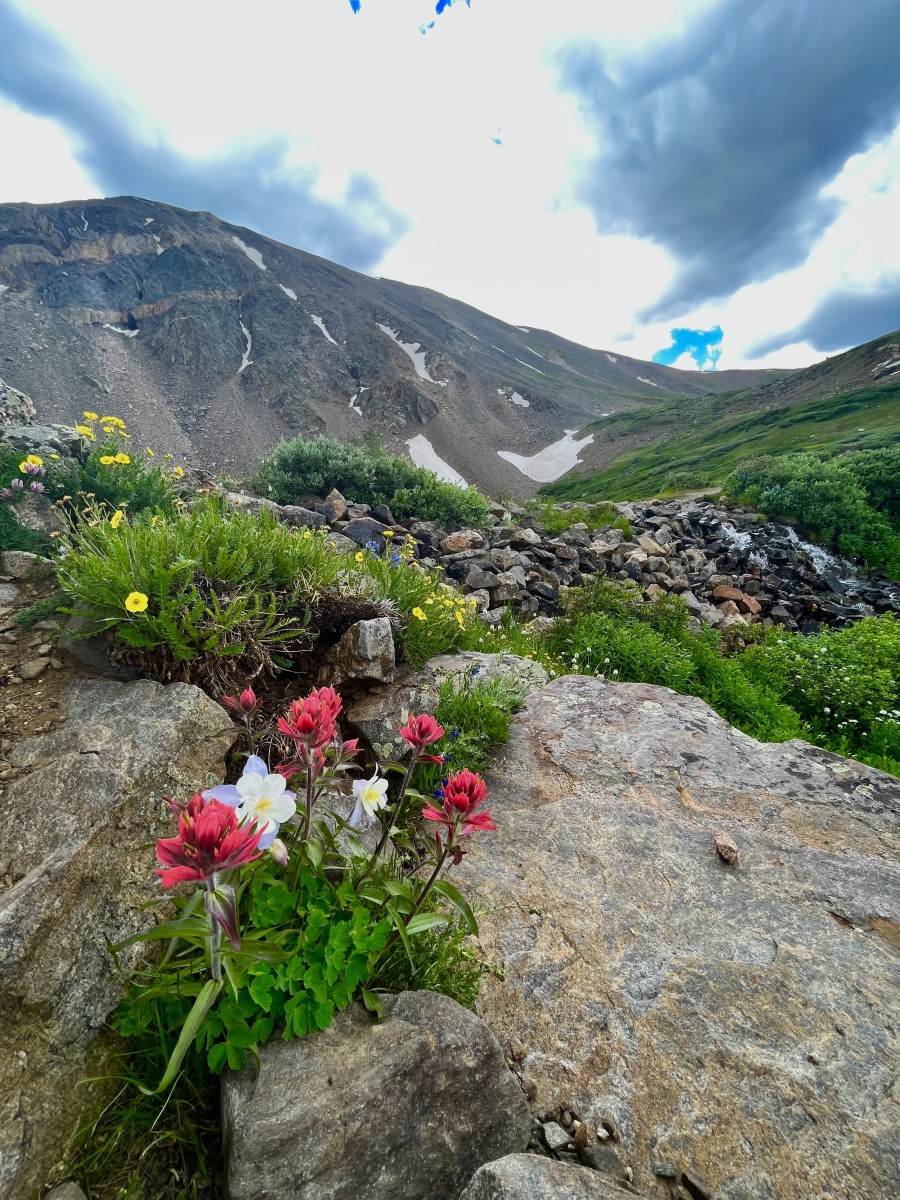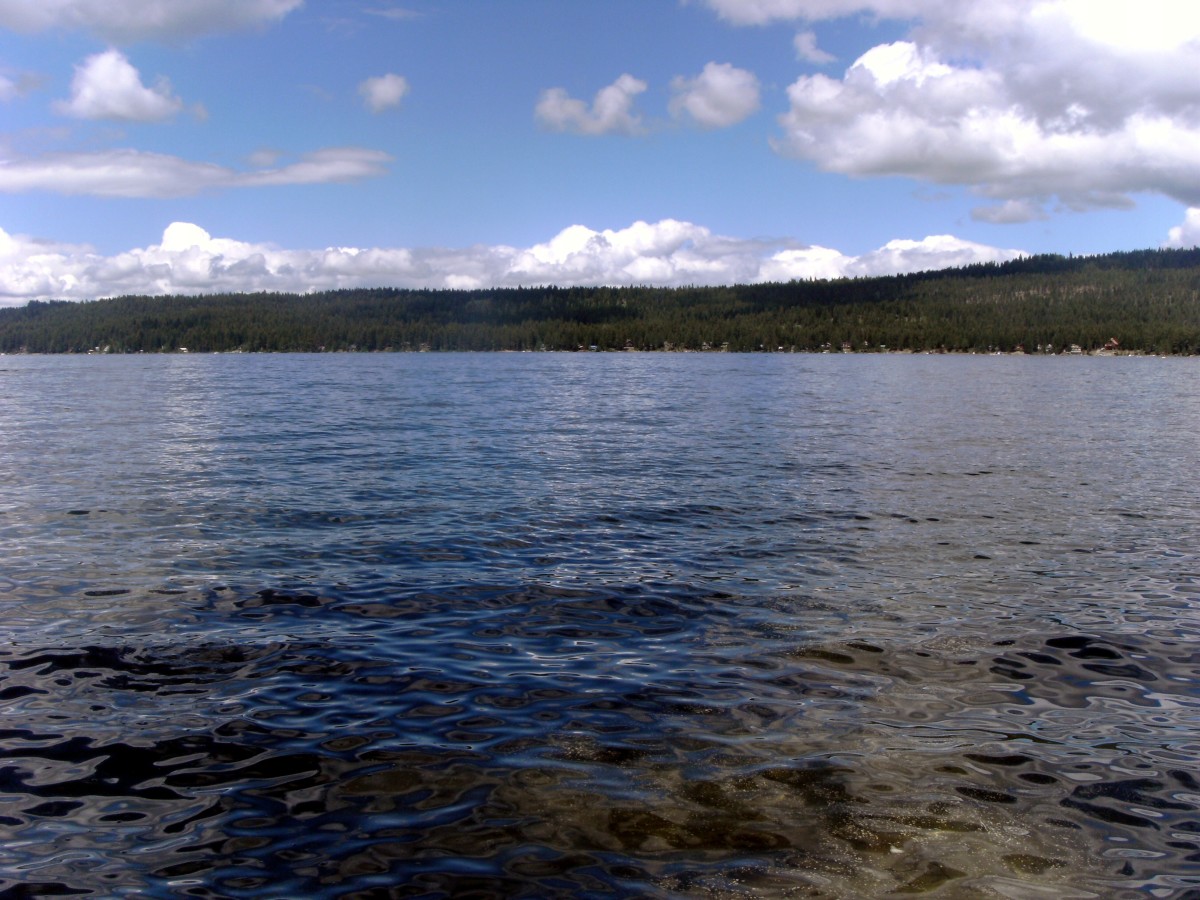Cabrillo Point Lighthouse
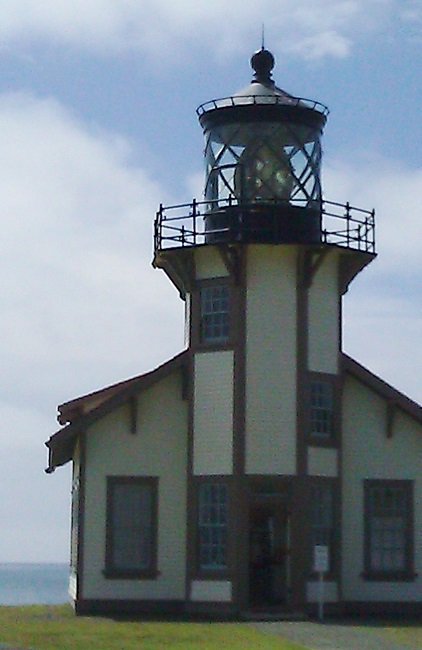
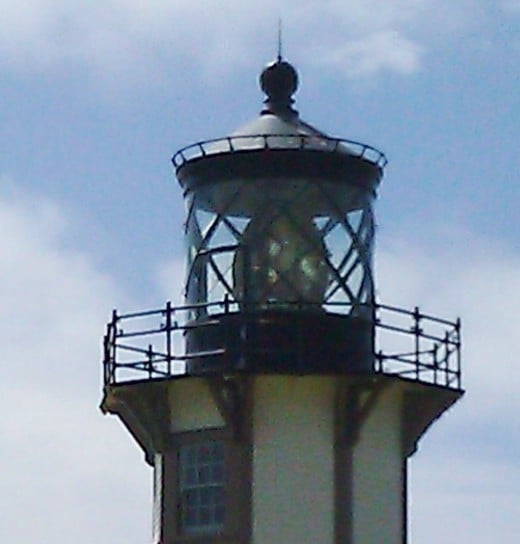
Have you visited California's Mendocino Coast?
Have you visited California's Mendocino Coast and the Cabrillo Lighthouse?
Visit Point Cabrillo Lighthouse on California's stunning Mendocino Coast
When you visit the Mendocino Coast, plan to spend an hour or two visiting the historic Point Cabrillo Lighthouse Station.
Spectacular scenery, wildlife and an unusual lighthouse are reason enough to take the charming (and short) biway to the station, now a California historic state park.
Then there is the Caretaker's Museum, unlike any I've visited. Housed in the Assistant Caretaker's actual home of days gone by, the museum could stand in for a model home of the time.
Lit by seascape windows on two sides and landscape panes on the other, it is airy, bright, and impeccably clean. At any moment I expected children to come clattering down the stairs, the old-fashioned wooden telephone to jingle, and an apron-clad housewife to invite us to tea.
Come along and I'll give you a tour of the station and museum, as well as some glimpses of the fantastic scenery in the park, a little history, and travel information, including how you can book an overnight stay--or a week--at the station yourself.
Celebrate National Lighthouse Day
August 7 is National Lighthouse Day, when those of us who are mesmerized by their history and lore pay homage to these life-saving beacons of light and hope shining out across the sea.
Assistant caretaker's cottage at lighthouse station entrance
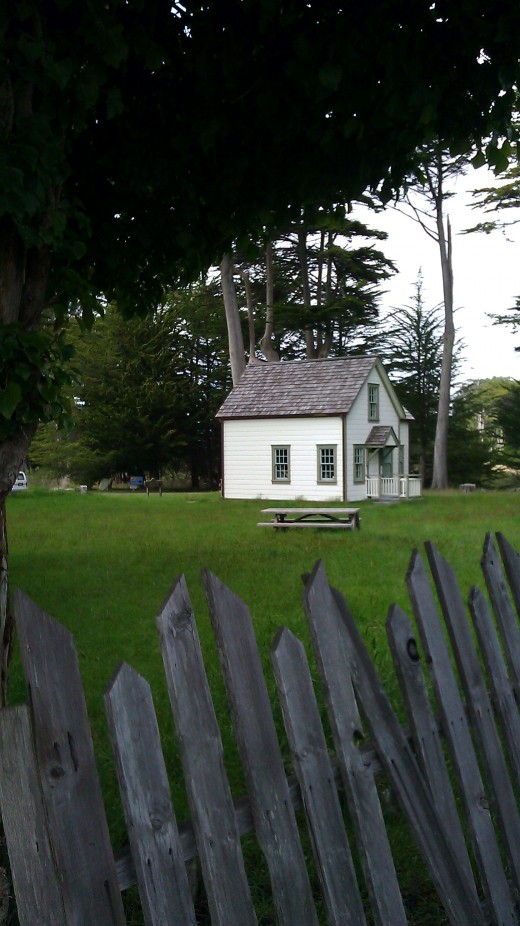
Directions to Point Cabrillo Lighthouse From Mendocino, CA
The lighthouse and station are located near Mendocino, California, about three hours north of San Francisco.
To get to Point Cabrillo Lighthouse from Mendocino, travel 1.7 miles north on scenic Highway 1, then turn left on Brest Road and take an almost immediate right onto Point Cabrillo Drive. It is well signed.
Follow the often tree-lined drive through the rolling coastal hills for another 1.2 miles to the station entrance, where you will see this charming cottage and meadow.
Park behind the cottage and stop for a bring-your-own lunch at one of two picnic tables before strolling through the wildlife preserve one-half mile to the lighthouse and caretaker homes on the headland.
Elders and people with disabilities can drive the paved lane to the lighthouse, where they will find accessible parking.
Directions source: Google Maps
Stroll half a mile through the wildlife preserve to the lighthouse, keepers' cottages and grounds
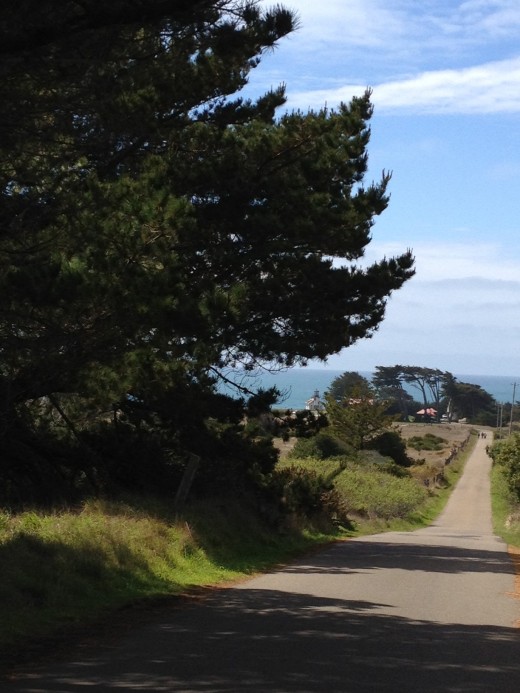
With the wild blue ocean following the curve of the Earth in a perfect arc before you, the short half-mile walk to the headland is both invigorating and relaxing. Soft breezes catch your hair on a sunny day like this one, and if you're watchful, you may see a herd of deer resting in the grass or shading themselves under distant trees.
If it's a warm day, do take a bottle of water (Reusable, I hope!), and be aware that there are no trash cans on the preserve. What you carry in, you carry out.
It's a short but incredibly gorgeous hike
You'll enjoy it most if you carry a few essentials. Even though it's a short half mile stroll, you'll be glad you grabbed items similar to these on your way down the lane.
Please, bring your own! There are no trash bins. Everything you carry down, you have to carry back up, so make sure you have what you need.
Binoculars are a must in whale-sighting country!
We never head to the Pacific seashore without a pair of binoculars. So many seabirds and other wildlife to spot! Plus, you never know when the whales might be spouting just off the point.
A stuff-sack reusable shopping bag
The lighthouse includes a lovely little store that has better-than-average tchotchkes, mementos and souvenirs, so tuck one of these bags in your pocket and you'll be all set.
Fill a reusable water bottle with fresh water or lemonade before you go
Kleen Kanteens are made from food-safe stainless steel, inside and out, so you never have to worry about weird tastes, smells or potentially dangerous leachates in your drinks.
This one has a cool carry loop and easy-access, pop-up drinking top.
Tote a few snacks, sweet and salty
Save money and carry your own quick snack bites in these fully-lined (no pthalates or bPA) organic cotton snack bags.
Picnic under the trees a short way from the parking lot
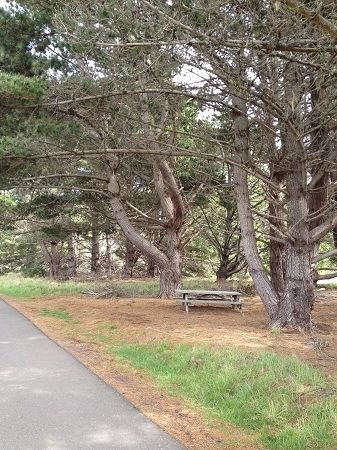
Learn more
Learn more about the history of the lighthouse, the preserve and the buildings and keepers on the Point Cabrillo Light Station web site.
Watch for deer and soaring raptors
Pack your picnic lunch down to this table (or take a break on the way back up the hill) and enjoy the sounds of prairie falcons, ravens, turkey vultures and songbirds swooping and calling across the preserve.
We saw evidence of deer having spent the night here, their body imprints still molded into the grass. Had we gone off the track, I've no doubt we'd have found scat as well.
Beware of venturing off path in deer country. Deer carry ticks that can carry Lyme disease. Protect yourself. Tuck your pant legs into your boots or socks, wear long sleeves and high collars. Always check yourself, your children and your pets for ticks after wandering in tall grass.
Looking northeast across the meadow - Flecks of wild iris are barely visible
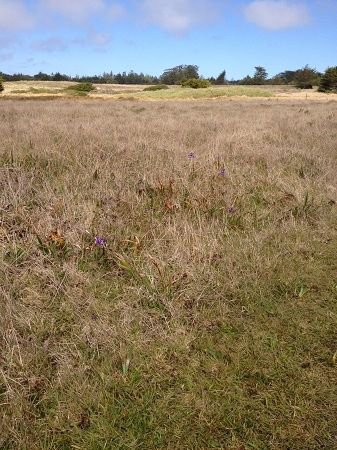
The meadows are already golden brown in April here, with little rain to pop out the green, but deep in the grass, we found lots of wild iris lifting their purple faces to the sun. If you look closely, you can just discern their purple heads here and there.
Wild Iris closeup
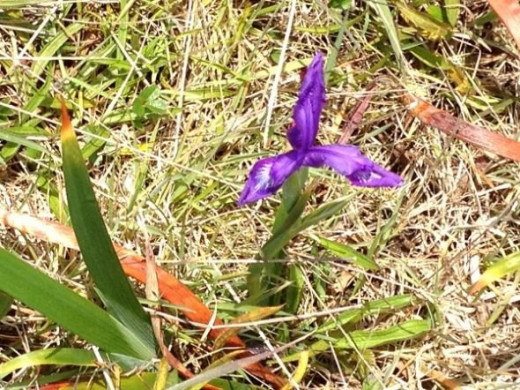
The deep purple bracts of the wild iris stand out against the brown grass.
Wild iris can be found along California, Oregon and Washington coast lines throughout the spring and early summer months. Botanists are not sure how wild iris migrated to North America. They speculate the seeds came with early mammal migrations across the Bering Strait when it was a land bridge.
This cheery specimen appears to be the Pacific Coast Native Iris, or bowl tube (ground) iris (Iris macrosiphon).
Just beyond this point we enter the lighthouse keepers' grounds
Caretaker's Home with lighthouse in distance
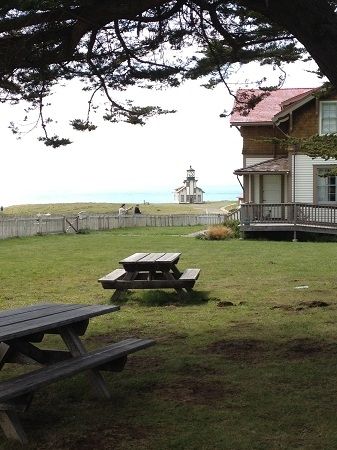
The blue, blue sea
We turn a bend at the end of the lane and enter the grounds proper. Back in 1909, when the lighthouse first cast its shining beam across the water, the caretaker and his family lived in this home.
Today, travelers can book rooms and stay here, enjoying the fresh ocean breezes, the sometimes wild weather, and the sunny days as they come. Two smaller buildings, once used by the caretaker and his assistants for maintaining the grounds and lighthouse, are also available for lodging.
Rental income helps maintain the property and keep it open for visitors seven days a week, year round.
Looking into the caretakers' back yard
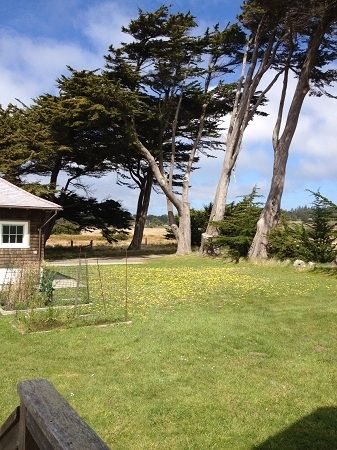
For a unique experience, stay in one of the caretaker cottages
The caretaker's house and two cabins on site are available for vacation rental. For more information, visit The Cottages | Point Cabrillo Light Station. (I am not affiliated with the organization and receive no compensation for referring you to them.)
Garden by kitchen door
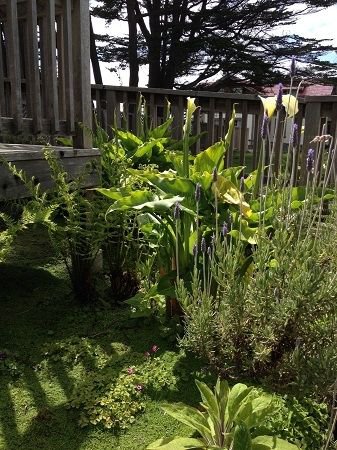
The caretaker's herb garden
In the early days, this would have been almost entirely an herb garden, perhaps with a few tomatoes as well. Today, while a few savory herbs remain, it is mostly ornamental.
In addition to annual salaries and housing, the caretaker, his assistants and their families were given use of the land to raise livestock and grow fresh produce for their tables.
What a life it must have been! To have the roar and shushu of the sea marking time wave by wave and tide by tide, to bear the brunt of the wild Pacific storms all winter long, and race across the meadows with kites aloft on better days.
Entering the caretaker's museum through the back porch and wash room
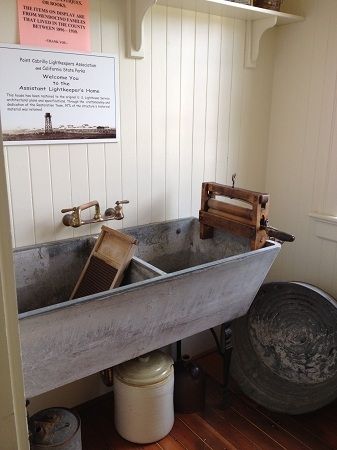
Entering the caretaker's museum from the kitchen garden, we first see the then state-of-the-art laundry facility on the back porch.
The caretaker's museum is housed in the smaller assistant caretaker's home. The second story, up a beautiful hand carved banister, is off limits to visitors, but the entire downstairs is wonderfully restored so it looks brand new, with authentic antiques.
Walking in, I feel right at home. Many of the furnishings I remember well from the homes of my grandparents and other "old" people of my childhood.
The caretaker's wife did her laundry on the back porch, much as my own mother did
The first thing we see, walking onto the enclosed back porch from the tree-shaded back yard, is the laundry tub. Rather, we see tubs--three of them--complete with a hand-turned wringer for squeezing the water from clothing.
My mother had a setup very like this when I was a child, except that by then she had an electric wringer washing machine. Here, we see hot and cold running water taps, a modern convenience indeed; but to fill her machine's tub, Mom heated buckets of water for the hot white wash, which always had to go first.
While the machine agitated the whites in scalding hot suds, Mom heated the rinse water. All four burners of the stove were turned on high.
When the agitation cycle finished, Mom pulled the plug to drain the tub while she ran the clothes one by one through the wringer and into a washtub just like the round one you see in the corner here, shouting all the while at we children to keep our fingers away from the ringer. She had to shout because the machine made a terrible racket.
After ringing the clothes, Mom filled the washer with the now-hot rinse water, tossed them all back in and let them agitate through the rinse cycle while she filled the round tub with bucket after bucket of cold water.
Mind you, we did not have running water, even though this was the fifties. Every bucket came from a hand pump over a well. It was my job, and my brother and sister's as well, to pump those buckets full, one after the other.
Once the whites were rinsed in hot water, Mom pulled them out, added suds to the still churning machine and folded in a load of warm-wash colors to agitate while she rung the whites through the ringer again into the cold rinse tub.
This time, she rinsed each garment by hand, running it through the ringer a third time into a bushel basket she used as a laundry basket. We girls would take the bushel basket to the line and pin the clothes. Boy did they smell good after a sunny day on the line.
So it went, load after load, hauling buckets of water, agitating, wringing, rinsing. I can only imagine what the women of the early 1900s went through, doing it all by hand, without electricity.
Caretaker's Kitchen
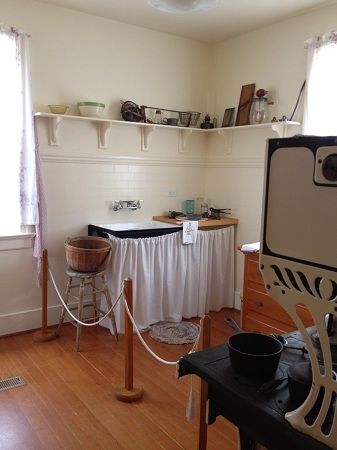
The small kitchen is warm and inviting
The enameled wood warmer oven in the right foreground was a step up from the black cast-iron stoves (like the stove below it) many people had at the turn of the last century. Likewise the sunken sink and hot and cold running water taps.
I can't help wondering how they heated the water. Gas, perhaps? Of course, it wasn't long before electricity made its way to middle class homes across the country.
The Saga of the Caretaker's Wife
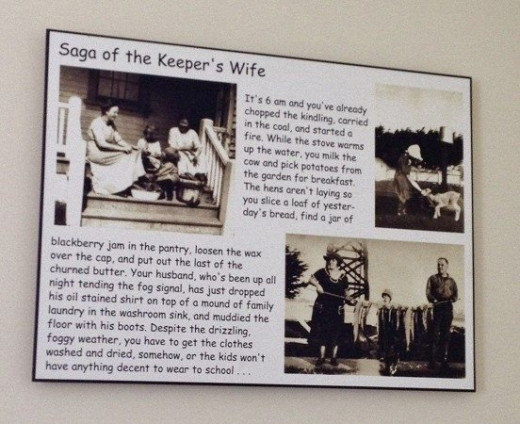
Think she got to go to a spa now and then?
If there were bon-bons and spa days for the caretaker's wife, they were few and far between.
Built-in storage, lovingly crafted in the caretaker's dining room
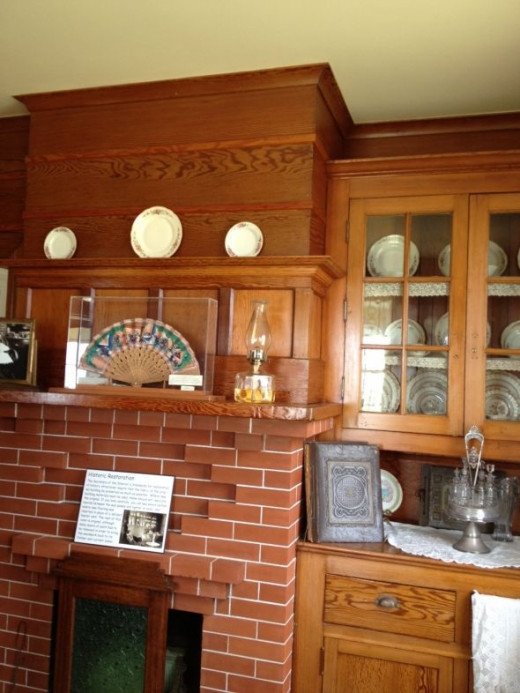
In a small house with small rooms, storage was managed ingeniously and thoughtfully throughout the house. This built in china cabinet is beautifully crafted in what appears to be white oak, which may have been shipped round the horn in those days.
Telephone service was a vital necessity for the lighthouse keeper
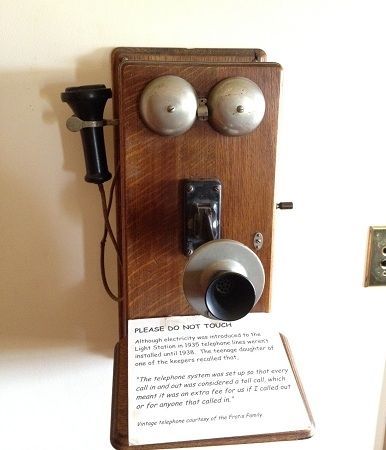
Are you old enough to remember these phones?
Telephone service meant the lighthouse keeper could get word quickly if he spied a ship in trouble near shore. To operate it, he would have had to crank it by hand, hold the receiver to his ear, and speak into the mouthpiece.
When I was just a tot, the only nearby phone was one like this in the general store. If someone wanted to talk to my mom or dad, they called long distance and held on while the storekeeper sent one of her children to fetch us.
Later, in the mid-fifties, there were still plenty of these phones hanging on cafe walls and in people's homes. Sure, by then most people had the sleek, black table phone with the dumbbell-shaped receiver and mouthpiece in one, but not everyone, especially in farm country.
Arts, crafts and toys show the detailed handiwork of the age
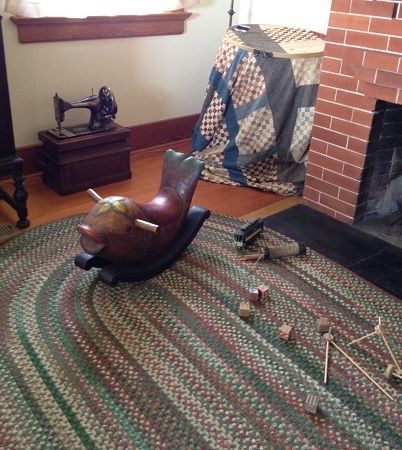
The small living room and its fireplace would have been cozy on a stormy night
The first thing we notice stepping past a gleaming staircase and banister into the living room is the finely crafted rocking whale for baby. Tinker toys and other playthings are scattered here and there as if the children just this minute ran outside.
In the background, you see the hand-cranked sewing machine and the quilting/embroidery rack. Imagine sitting cozy and warm with the fire on a stormy night, windows shuttered against the wind and pelting rain, Mama's voice cooing lullabies while she stitches colorful threads into the new quilt.
The caretaker's study and desk
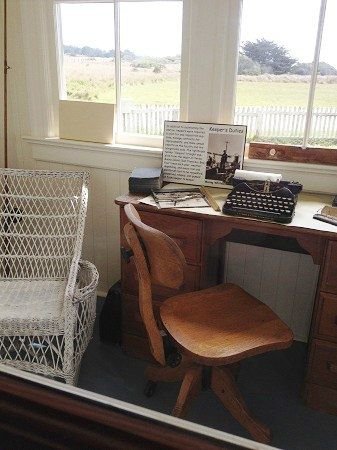
Keeping records was a vital part of the caretaker's responsibilities. The typewriter is an old Smith-Corona. We can almost hear the clacking and pinging as the carriage is thrown back line after line, while the children play at stick ball outside.
Leaving the caretaker's museum, toward the lighthouse
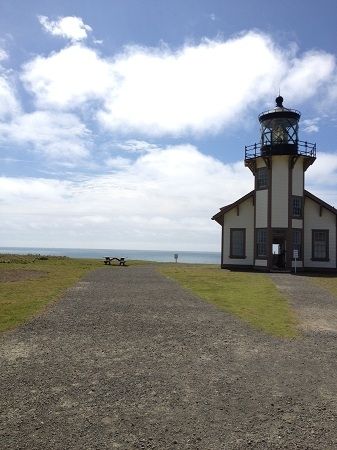
To the lighthouse
Virginia Woolf never plied these shores, but she knew something about the sea and lighthouses, didn't she?
Leaving the caretaker's museum, we head down the gravel path to the lighthouse, its beacon rotating brightly even on this sunny day. Unlike so many cylindrical lighthouse towers, this one is perched atop a small building, now serving as a gift shop, though it also has some museum pieces showing the workings.
Alas, the shop was crowded with visitors that day and I could not get a good shot of the interior. Do visit the shop. All proceeds go to maintaining the facility. This year, they're raising funds to replace the ancient roof.
The lighthouse with its gem-like crystal lens
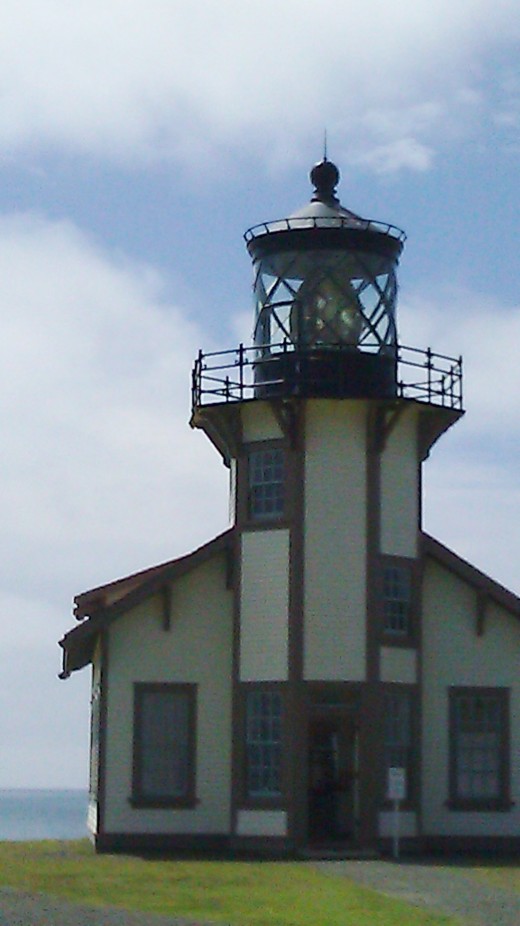
The crystal lens weighs several tons
The lens in the tower is enormous and weighs several tons. The multi-faceted lens is like an enormous diamond. Watching its dazzling light come round every 10 seconds mesmerized us.
Just enough mist in the air clouded my shots a bit, try as I might, but I hope you can imagine the brilliance of the lens, even with the afternoon light behind it.
In the early days, before electricity, the lighthouse keeper and his assistants kept the beacon shining with kerosene lamps. Can you imagine what is must have been like for them to be always on the alert to refill the lamp 24-7? Not only that, they physically rotated the lens, by hand-cranking a heavy chain around a barrel, then releasing it slowly and cranking it again.
Future cleft and landslide?
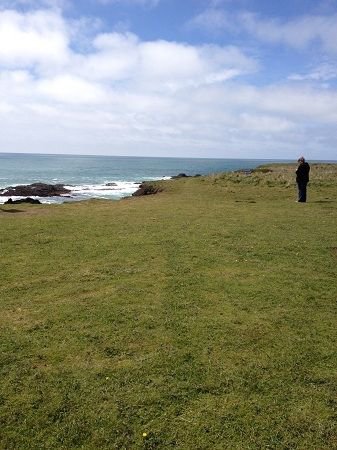
Ground splitting?
Indentation in the ground appears to be following the contour of the rock. See the line of darker grass flowing toward the cliff edge?
Unless a lot of lemmings beat a path there recently, this slight declination in the ground may herald a crack in the underlying rock. I so wanted to find a geologist and ask about it!
The south gorge
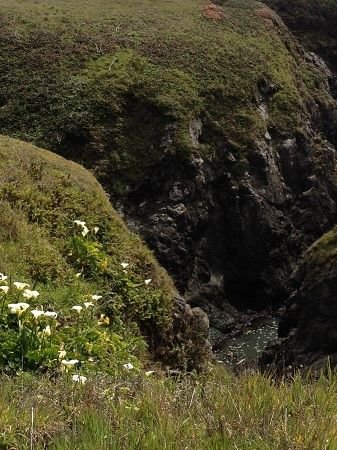
One of two gorges slowly eating their way around the lighthouse
The lighthouse is surrounded by two gorges slowly eating their way around and behind it. One day, they will meet.
Very likely, and for a time, a land bridge will connect the lighthouse and its crumbling headland to the mainland. Eventually, even that bridge will fail, and the lighthouse will sit isolated on its ever eroding sandstone bluff.
The northeast gorge
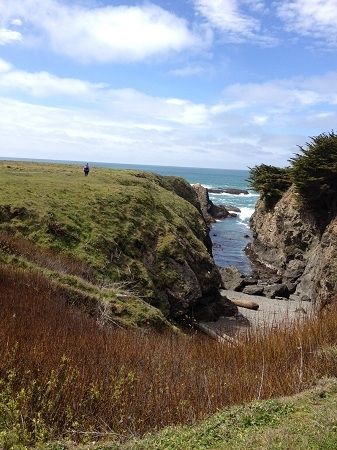
The northern gorge is longer and seems not as deep
The sea pounds and washes and grinds away at the sandstone, slowly digging around behind the lighthouse until one day the brine will meet itself and cut the lighthouse and its headland from the mainland, creating a new headland.
Our trek uphill is slower than our stroll down
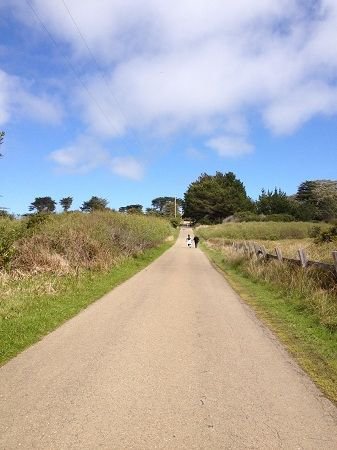
The slight incline slows us a little, but the wildlife stopped us altogether
On the way back up the hill, we paused frequently to view deer, who stared back at us as curious, it seemed, as we.
We paused, too, to take in the soaring raptors overhead, red-tailed hawks, ravens and others we could not identify. Everywhere, sweet birdsong regaled us with happy tunes.
We turned a few times for last looks of the sea and grassland
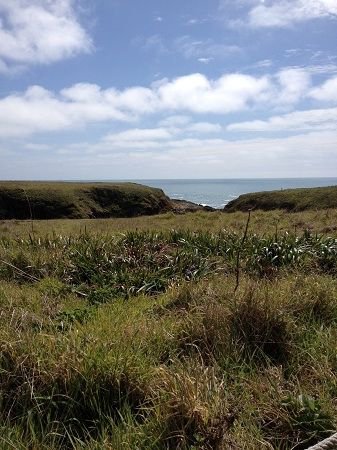
One last look at meadow stretching to sea. Throughout our visit at the lighthouse, spectacular views took our breath away, one after another, after another.

Where did the station get its name?
Spanish explorer and conquistador Juan Rodríguez Cabrillo followed Hernán Cortés to the new world and made his fortune vanquishing the native people and stealing their gold.
Cabrillo is considered the first European to navigate and chart the California coast. In 1542 he led an expedition of three ships up the coast as far as the Russian River, before turning south for the winter.
Though Cabrillo lived by the sword, he put the maxim to lie when he stubbed his toe and fell on a jagged rock, breaking his shin bone. Gangrene from the wound killed him a few months later, on January 3, 1543.
Numerous California sites, including some schools and a highway, also bear Cabrillo's name. Curiously, Cabrillo never made it as far north as Mendocino, nor to the headland that bears his name.
Point Cabrillo Light Station - by Bruce Rogerson and the Point Cabrillo Lightkeepers Association
See the men and women who kept the light on for sailors year round. Enjoy the smiling faces of their robust children and proud displays of enormous fish catches, along with other photographs of the time.
A dazzling, captivating compendium of history, anecdotes and superb photographs, this gem of a book gives us an inside look at life in the light station.
In addition to hundreds of photographs, the book includes intriguing sketches, diagrams and the lighthouse blueprint, all sure to delight the history buff and enlighten the curious.
Thank you for taking this virtual tour with me
Perhaps one day you will visit our Northern California coast and take an hour to visit this beautifully restored site.
© 2012 Kathryn Grace





